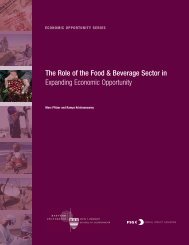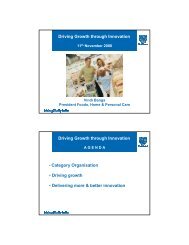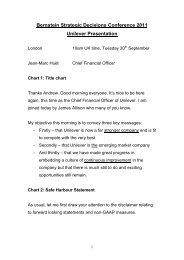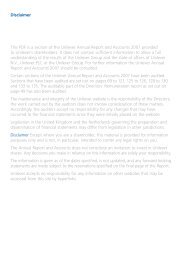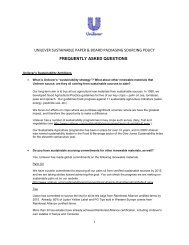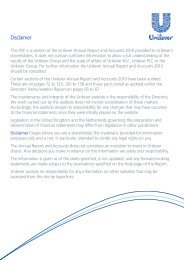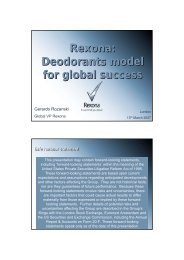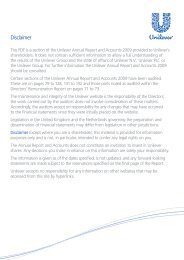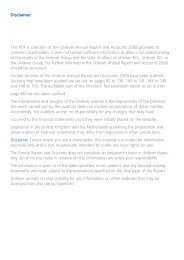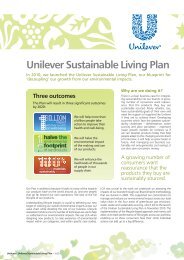Unilever Annual Report and Accounts 2004
Unilever Annual Report and Accounts 2004
Unilever Annual Report and Accounts 2004
Create successful ePaper yourself
Turn your PDF publications into a flip-book with our unique Google optimized e-Paper software.
Financial review<br />
(continued)<br />
In 2003, the principal disposals were Ambrosia in the United<br />
Kingdom, John West in Australasia, cheese businesses in Austria<br />
<strong>and</strong> Germany <strong>and</strong> the Pamol oil business in Malaysia. Various<br />
trademarks were also sold as part of our Path to Growth strategy,<br />
including Brut in the US <strong>and</strong> Latin America <strong>and</strong> a number of oral<br />
care br<strong>and</strong>s in the US.<br />
For further information on the impact of acquisitions <strong>and</strong><br />
disposals refer also to the cash flow section of the Financial<br />
Review on page 22 <strong>and</strong> to note 26 on page 134.<br />
<strong>2004</strong><br />
Dividends <strong>and</strong> market capitalisation<br />
The proposed final dividend of €1.26 per €0.51 share brings the<br />
dividends paid <strong>and</strong> proposed on the NV ordinary capital to €1.89<br />
per €0.51 share (2003: €1.74), an increase of 9% per share. The<br />
proposed final dividend of 12.82p per 1.4p share brings the<br />
dividends paid <strong>and</strong> proposed on the PLC ordinary capital to<br />
19.15p per 1.4p share (2003: 18.08p), an increase of 6% per<br />
share. The ratio of dividends to profit attributable to ordinary<br />
shareholders was 98.2% (2003: 61.5%). <strong>Unilever</strong>’s combined<br />
market capitalisation at 31 December <strong>2004</strong> was €49.3 billion<br />
(2003: €51.1 billion).<br />
Balance sheet<br />
During <strong>2004</strong>, net debt decreased to €9 663 million (2003:<br />
€12 555 million). This was due to strong operating cash flow,<br />
the proceeds of business disposals <strong>and</strong> the favourable effect of<br />
currency movements. Borrowings at the end of <strong>2004</strong> totalled<br />
€12 048 million (2003: €15 900 million). Taking into account the<br />
various cross currency swaps <strong>and</strong> other derivatives, 58% (2003:<br />
51%) of <strong>Unilever</strong>’s borrowings were in US dollars, <strong>and</strong> 15%<br />
(2003: 30%) in euros, with the remainder spread over a large<br />
number of other currencies. Further details of the currency<br />
analysis are given in note 15 on page 118.<br />
Long-term borrowings decreased by €1 573 million to<br />
€6 893 million at the end of <strong>2004</strong>. At the end of <strong>2004</strong>, shortterm<br />
borrowings were €5 155 million (2003: €7 434 million),<br />
including €1 898 million of long-term debt coming to within a<br />
year of maturity at the year end. At the end of <strong>2004</strong>, 63% of<br />
the long-term debt is repayable within five years (2003: 66%).<br />
<strong>Unilever</strong> has committed credit facilities in place to support its<br />
commercial paper programmes <strong>and</strong> for general corporate<br />
purposes. The undrawn committed credit facilities in place at the<br />
end of <strong>2004</strong> were: bilateral committed credit facilities totalling<br />
US $3 937 million, bilateral notes commitments totalling<br />
US $200 million <strong>and</strong> bilateral money market commitments<br />
totalling US $2 080 million. Further details regarding these<br />
facilities are given in note 15 on page 119.<br />
During <strong>2004</strong>, a total of €843 million was raised through term<br />
financing. This mainly consisted of bank loans in China for an<br />
equivalent of €121 million, a series of bank loans <strong>and</strong> a private<br />
note placement in Japan totalling an equivalent of €569 million<br />
<strong>and</strong> an equivalent of €130 million in the Philippines.<br />
<strong>Unilever</strong> is satisfied that its financing arrangements are adequate<br />
to meet its working capital needs for the foreseeable future.<br />
<strong>Unilever</strong>’s contractual obligations at the end of <strong>2004</strong> included<br />
capital expenditure commitments, borrowings, lease<br />
commitments <strong>and</strong> other commitments. A summary of certain<br />
contractual obligations at 31 December <strong>2004</strong> is provided in the<br />
table below. Further details are set out in the following notes to<br />
the accounts: note 10 on page 114, note 15 on page 118 <strong>and</strong><br />
note 25 on page 134. Details on derivatives are given in note 16<br />
on pages 120 <strong>and</strong> 121.<br />
Contractual obligations at 31 December <strong>2004</strong><br />
€ million € million € million € million € million<br />
Due Due in<br />
within Due in Due in over<br />
Total one year 1-3 years 3-5 years 5 years<br />
Long-term debt 8 791 1 898 3 808 528 2 557<br />
Operating lease<br />
obligations 1 895 334 530 424 607<br />
Purchase obligations (a) 218 139 62 2 15<br />
Finance leases 285 55 102 53 75<br />
Other long-term<br />
commitments 746 152 361 55 178<br />
(a) Raw <strong>and</strong> packaging materials <strong>and</strong> finished goods.<br />
Cash <strong>and</strong> current investments at the end of <strong>2004</strong> totalled<br />
€2 603 million (2003: €3 345 million); these funds were held in<br />
euros (77%), sterling (1%), US dollars (2%), Indian rupee (6%)<br />
<strong>and</strong> other currencies (14%). The funds are mainly to support dayto-day<br />
needs <strong>and</strong> are predominantly invested in short-term bank<br />
deposits <strong>and</strong> high-grade marketable securities. Further details of<br />
the currency analysis are given in note 14 on page 117.<br />
In <strong>2004</strong>, pension liabilities less plan assets (after allowing for<br />
deferred tax) amounted to €3 918 million (2003: €3 759 million).<br />
Profit retained reduced slightly from €6 190 million to<br />
€6 097 million after accounting for dividends (€1 843 million)<br />
<strong>and</strong> a currency retranslation gain of €83 million. The main<br />
components of the decline were the actuarial losses net of<br />
investment returns on pension plans of €454 million net of tax,<br />
offset by a gain of €222 million in respect of the reversal of the<br />
non-cash share option costs recorded in operating profit.<br />
Total capital <strong>and</strong> reserves decreased to €5 534 million (2003:<br />
€5 920 million), reflecting the above movements in profit retained<br />
together with a €324 million cost arising on the change in book<br />
value of shares or certificates held to meet share options. On<br />
the face of the balance sheet on page 101, an analysis is given<br />
indicating how consolidated capital <strong>and</strong> reserves are attributed to<br />
NV <strong>and</strong> PLC. PLC currently has negative consolidated reserves; this<br />
arises largely because of an accounting policy of writing off<br />
goodwill arising in previous years; these write-offs do not have an<br />
impact on distributable reserves.<br />
In November 2001, NV entered into a forward purchase contract<br />
with a counterparty bank to buy 10 000 000 PLC shares at 559p<br />
per share in November 2006 to meet the obligation to employees<br />
under share option plans. If the PLC share price falls by more than<br />
5% below 559p, cash collateral for the difference must be placed<br />
with the counterparty bank. At year end, €24 million of collateral<br />
had been placed with counterparties.<br />
<strong>Unilever</strong> <strong>Annual</strong> <strong>Report</strong> <strong>and</strong> <strong>Accounts</strong> <strong>2004</strong> 21




